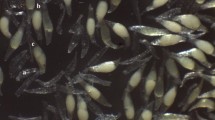Abstract
The breeding system of the extremely diverse species Persoonia mollis (Proteaceae) was characterized to, firstly, assess its importance as a mechanism promoting diversity and, secondly, to investigate the mode of control over selective fruit abortion. Fruit quantity and quality was assessed following self-and outcross-pollination manipulations. Twenty percent of outcrossed flowers set fruit, compared to only 1% of flowers fertilized with self-pollen. Fruits produced by self-fertilization were 72% of the weight of cross-fertilized fruits. Fruits produced by self-fertilization were significantly fewer in number and lighter than fruits following natural pollination of unmanipulated flowers (17% fruit set), but outcrossed and naturally pollinated fruits were equivalent. Flower to fruit demography suggested that a post-zygotic mechanism may be preferentially selecting the most vigorous zygote genotypes, as ovary abscission occurs mostly between 4 and 30 weeks after pollination, regardless of pollen source. Self-pollen tube growth was found to be inhibited within the styly, while pollen tubes were found in the ovary for 50% of all outcrossed flowers. These data suggest that a pre-zygotic “pseudo” self-incompatibility mechanism is the cause of low fruit set following self-pollination. The breeding system of P. mollis was found to promote outbreeding, with an emphasis on flexibility and post-zygotic choice following pre-zygotic “pseudo” self-incompatibility.
Similar content being viewed by others
References
Abbott I, Heurck P van (1988) Widespread regeneration failure of Persoonia elliptica (Proteaceae) in the northern Jarrah forest of Western Australia. J R Soc West Aus 71:15–22
Aizen MA, Searcy KB, Mulcahy DL (1990) Among- and within-flower comparisons of pollen-tube growth following self- and cross-pollinations in Dianthus chinensis (Cryophyllaceae). Am J Bot 77:671–676
Ayre DJ, Whelan RJ (1989) Factors controlling fruit-set in hermaphroditic plants: studies with the Australian Proteaceae. Trends Ecol Evol 4:267–272
Bateman AJ (1956) Cryptic self-incompatibility in the wallflower: Cheiranthus cheiri L. Heredity 10:257–261
Bookman SS (1984) Evidence for selective fruit production in Asclepias. Evolution 38:72–86
Casper BB (1988) Evidence for selective embryo abortion in Cryptantha flava. Am Nat 132:318–326
Collins BG, Rebelo T (1987) Pollination biology of the Proteaceae in Australia and southern Africa. Aust J Ecol 12:387–421
Ehrlich PR, Raven PH (1969) Differentiation of populations. Science 165:1228–1232
Goldingay RL, Whelan RJ (1990) Breeding system and tests for pollen-limitation in two species of Banksia. Aust J Bot 38:63–71
Goldingay RL, Schibeci SM, Walker BA (1991) Breeding system and pollination levels of Banksia ericifolia. Aust J Bot 39:365–372
Griffin AR, Moran GF, Fripp YJ (1987) Preferential outcrossing in Eucalyptus regnans F. Muell. Aust J Bot 35:465–475
Harper JL (1977) Population biology of plants. Academic Press, New York
Harriss F, Whelan RJ (1993) Selective fruit abortion in Grevillea barklyana (Proteaceae). Aust J Bot 41:499–509
Janzen DH (1977) A note on optimal mate selection in plants. Am Nat 111:365–371
Johnson LAS, Briggs BG (1963) Evolution in the Proteaceae. Aust J Bot 11:21–61
Johnston MO (1992) Effects of cross and self-fertilization on progeny fitness in Lobedlia cardinalis and L. siphilitica. Evolution 46:688–702
Kenrick J, Knox RB (1989) Quantitative analysis of self-incompatibility in trees of seven species of Acacia. J Heredity 80:240–245
Kohn JR, Waser NM (1985) The effect of Delphinium nelsonii pollen on seed set in Ipomopsis aggregata a competitor for hummingbird pollination. Am J Bot 72:1144–1148
Krauss SL (in press) Restricted gene flow within the complex species Persoonia mollis (Proteaceae): contrasting evidence from the mating system and pollen dispersal. Heredity
Krauss SL, Johnson LAA (1991) A revision of the complex species Persoonia mollis (Proteaceae). Telopea 4:185–199
Lamont BB, Collins BG, Cowling RM (1985) Reproductive biology of the Proteaceae in Australia and South Africa. Proc Ecol Soc Aust 14:213–224
Levin DA (1981) Dispersal versus gene flow in plants. Ann MO Bot Gard 68:233–253
Levin DA, Kerster HW (1974) Gene flow in seed plants. Evol Biol 7:139–220
Marshall DL (1986) Effect of seed size on seedling success in three species of Sesbania (Fabaceae). Am J Bot 73:457–464
Martin FW (1959) Stanning and observing pollen tubes in the style by means of fluorescence. Stain Technol 34:125–128
Michener CD (1973) “Superfamily APOIDEA”. The insects of Australia (CSIRO). Melbourne University Press, Melbourne
Montalvo AM (1992) Relative success of self and outcross pollen comparing mixed- and single-donor pollinations in Aquilegia caerulea. Evolution 46:1181–1198
Mulcahy D, Mulcahy GB (1985) Gametophytic self-incompatability or the more things change... Heredity 54:139–144
Nettancourt de D (1977) Incompatibility in angiosperms. Springer, Berlin Heidelberg New York
Paton DC, Turner V (1985) Pollination of Banksia ericifolia Smith: birds, mammals and insects as pollen vectors. Aust J Bot 33:271–286
Primack RB (1987) Relationships among flowers, fruits and seeds. Annu Rev Ecol Syst 18:409–430
Seavey SR, Bawa KS (1986) Late-acting self-incompatibility in angiosperms. Bot Rev 52:195–219
Siegal S (1956) Nonparametric statistics for the behavioral sciences. McGraw-Hill, New York
Slatkin M (1985) Gene flow in natural populations. Annu Rev Ecol Syst 16:393–430
Slatkin M (1987) Gene flow and the geographic structure of natural populations. Science 236:787–792
Snow AA, Spira TP (1991) Differential pollen-tube growth rates and nonrandom fertilization in Hibiscus moscheutos (Malvaceae). Am J Bot 78:1419–1426
Stephenson AG (1981) Flower and fruit abortion: proximate causes and ultimate function. Annu Rev Ecol Syst 12:253–279
Stephenson AG, Winsor JA (1986) Lotus corniculatur regulates offspring quality through selective fruit abortion. Evolution 40:453–458
Templeton AR (1989) The meaning of species and speciation: a genetic perspective. In: Otte D, Endler JA (eds) Speciation and its consequences. Sinauer, Sunderland, Mass., pp 3–27
Underwood AJ (1981) Techniques of analysis of variance in experimental marine biology and ecology. Oceanogr Mar Biol Annu Rev 29:513–605
Vaughton G (1988) Pollination and seed set of Banksia spinulosa: evidence for autogamy. Aust J Bot 36:633–642
Waser NM (1993) Population structure, optimal outbreeding and assortative mating in angiosperms. In: Thornhill NW (ed) The natural history of inbreeding and outbreeding — theoretical and empirical perspectives. The University of Chicago Press, Chicago, pp 173–199
Waser NM, Price MV (1983) Optimal and actual outcrossing, and the nature of plant-pollinator interaction. In: Jones CE, Little RJ (eds) Handbook of experimental pollination biology. Van Nostrand Reinhold, New York, pp 341–359
Waser NM, Price MV (1991) Reproductive costs of self-pollination in Ipomopsis aggregata (Polemoniaceae): are ovules usurped? Am J Bot 78:1036–1043
Weller SG, Ornduff R (1977) Cryptic self-incompatability in Amsinckia grandiflora. Evolution 31:47–51
Westoby M, Rice B (1982) Evolution of fitness of the seed plants and inclusive fitness of plant tissue. Evolution 36:713–724
Whelan RJ, Goldingay RL (1986) Do pollinators influence seedset in Banksia paludosa Sm. and Banksia spinulosa R.Br.? Aust J Ecol 11:181–186
Whelan RJ, Goldingay RL (1989) Factors affecting fruit-set in Telopea speciosissima (Proteaceae): the importance of pollen limitation. J Ecol 77:1123–1134
Wiens D (1984) Ovule survivorship, brood size, life history, breeding systems and reproductive success in plants. Oecologia 64:47–53
Wiens D, Nickrent DL, Davern CI, Calvin CL, Vivrette NJ (1989) Developmental failure and loss of reproductive capacity in the rare palaeoendemic shrub Dedeckera eurekensis. Nature 338:65–67
Wilkinson L (1988) SYSTAT: the system for statistics. SYSTAT Inc, Evanston, Ill.
Willson M, Burley N (1983) Mate choice in plants. Princeton University Press, Princeton, NJ
Winer BJ (1979) Statistical principles in experimental design. McGraw-Hill, London
Wyatt R (1983) Pollinator-plant interactions and the evolution of breeding systems. In: Real L (ed) Pollination biology. Academic Press, Orlando, pp 51–95
Author information
Authors and Affiliations
Additional information
Publication no. 120 from the Ecology and Genetics Group of the University of Wollongong
Rights and permissions
About this article
Cite this article
Krauss, S.L. Preferential outcrossing in the complex species Persoonia mollis R. Br. (Proteaceae). Oecologia 97, 256–264 (1994). https://doi.org/10.1007/BF00323158
Received:
Accepted:
Issue Date:
DOI: https://doi.org/10.1007/BF00323158




